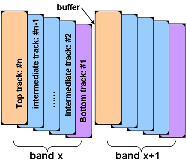Architecture for Hard Disk Drives
Abstract
Magnetic data storage has made rapid progress in terms of areal density over the past few decades. Current products have areal density levels that exceed 10(12) bits per square inch, about 1000 times greater than areal densities of the mid-1990s. Five component technologies have become hard-disk-drive industry standards over the past two decades: read heads based on giant magnetoresistance or tunneling magnetoresistance, perpendicular write heads, perpendicular recording media, heaters, and contact detection sensors. At the recording system level, shingled magnetic recording has been implemented by all disk-drive companies, but it has not become a new standard due to the additional penalty in access time (or latency). Here, interlaced magnetic recording and blocked magnetic recording are introduced and compared with conventional and shingled magnetic recording.
- Authors:
-
- International Business and Technology Service, North Oaks, MN (United States)
- Publication Date:
- Research Org.:
- Argonne National Lab. (ANL), Argonne, IL (United States)
- Sponsoring Org.:
- USDOE
- OSTI Identifier:
- 1477760
- Grant/Contract Number:
- AC02-06CH11357
- Resource Type:
- Accepted Manuscript
- Journal Name:
- IEEE Magnetics Letters
- Additional Journal Information:
- Journal Volume: 9; Journal ID: ISSN 1949-307X
- Publisher:
- IEEE
- Country of Publication:
- United States
- Language:
- English
- Subject:
- 97 MATHEMATICS AND COMPUTING; Information Storage; Shingled Magnetic Recording; Blocked Magnetic Recording; Interlaced Magnetic Recording
Citation Formats
Gao, Kaizhong. Architecture for Hard Disk Drives. United States: N. p., 2018.
Web. doi:10.1109/LMAG.2018.2789888.
Gao, Kaizhong. Architecture for Hard Disk Drives. United States. https://doi.org/10.1109/LMAG.2018.2789888
Gao, Kaizhong. Fri .
"Architecture for Hard Disk Drives". United States. https://doi.org/10.1109/LMAG.2018.2789888. https://www.osti.gov/servlets/purl/1477760.
@article{osti_1477760,
title = {Architecture for Hard Disk Drives},
author = {Gao, Kaizhong},
abstractNote = {Magnetic data storage has made rapid progress in terms of areal density over the past few decades. Current products have areal density levels that exceed 10(12) bits per square inch, about 1000 times greater than areal densities of the mid-1990s. Five component technologies have become hard-disk-drive industry standards over the past two decades: read heads based on giant magnetoresistance or tunneling magnetoresistance, perpendicular write heads, perpendicular recording media, heaters, and contact detection sensors. At the recording system level, shingled magnetic recording has been implemented by all disk-drive companies, but it has not become a new standard due to the additional penalty in access time (or latency). Here, interlaced magnetic recording and blocked magnetic recording are introduced and compared with conventional and shingled magnetic recording.},
doi = {10.1109/LMAG.2018.2789888},
journal = {IEEE Magnetics Letters},
number = ,
volume = 9,
place = {United States},
year = {Fri Jan 05 00:00:00 EST 2018},
month = {Fri Jan 05 00:00:00 EST 2018}
}
Web of Science
Figures / Tables:
 Fig. 1 : Shingled magnetic recording architecture
Fig. 1 : Shingled magnetic recording architecture
Figures / Tables found in this record:

 Search WorldCat to find libraries that may hold this journal
Search WorldCat to find libraries that may hold this journal